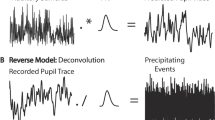Abstract
The maximum velocity of saccades is widely used in the clinical assessment of topographical diagnoses. Several methodological factors affect the maximum velocity results. The sampling frequency, the resolution of the analog-digital converter, and filtering of the signal are the most important factors. The sampling frequency should preferabel be higher than 300 Hz. Frequencies below 200 Hz severily deform the velocity profile. The resolution of the analog-digital converter should be 10 bits or more. A theoretical model was constructed for maximum velocity computation. A case study of electro-oculographic and photoelectric recordings confirmed the theoretical model.
Similar content being viewed by others
References
Bahill AT, Brockenbrough A, Troost BT (1981) Variability and development of a normative data base for saccadic eye movements. Invest Ophthalmol Vis Sci 21:116–125
Bahill AT, Kallman JS, Lieberman JE (1982) Frequency limitations of the two-point central difference differentiation algorithm. Biol Cybern 45:1–4
Bahill AT, McDonald JD (1983a) Frequency limitations and optimal step size for the two-point central difference derivative algorithm with applications to human eye movement data. IEEE Trans Biomed Eng BME-30:191–194
Bahill AT, Kallman JS (1983b) Predicting final eye position halfway through a saccade. IEEE Trans Biomed Eng BME-30:781–786
Baloh RW, Sills AW, Kumley WE, Honrubia V (1975a) Quantitative measurement of saccade amplitude, duration, and velocity. Neurology 25:1065–1070
Baloh RW, Konrad HR, Sills AW, Honrubia V (1975b) The saccade velocity test. Neurology 25:1071–1076
Baloh RW, Langhofer L, Honrubia V, Yee RD (1980) Online analysis of eye movements using a digital computer. Aviat Space Environ Med 51:563–567
Boghen D, Troost BT, Daroff RB, Dell'Osso LF, Birkett JE (1974) Velocity characteristics of normal human saccades. Invest Ophthalmol 13:619–623
Dick GL (1978) Computer analysis of rapid eye movements. Comput Programs Biomed 8:29–34
Fricker SJ, Sanders JJ (1975) Velocity and acceleration statistics of pseudorandomly timed saccades in humans. Vision Res 15:225–229
Henriksson NG, Pyykkö I, Schalén L, Wennmo C (1980) Velocity patterns of rapid eye movements. Acta Otolaryngol (Sweden) 89:504–512
Jäntti V (1982) Designing a quantitative automatic analysis system for horizontal saccade eye movements: An electrooculographic study with special reference to the effect of alcohol on saccades. Academic dissertation, Faculty of Medicine University of Turku, Turku, Finland
Oppenheim AW, Schafer RW (1975) Digital signal processing. Prentice-Hall, Englewood Cliffs, New Jersey
Pyykkö I, Hamid MA, Matsuoka I, Schalén L (1980) Interpretation of nystagmogram. II Saccades and smooth pursuit eye movements. Practic Otolaryngol (Jpn) 73:2045–2053
Schmidt D, Abel LA, Dell'Osso LF, Daroff RR (1979) Saccadic velocity characteristics: Intrinsic variability and fatigue. Aviat Space Environ Med 50:393–395
Usui S, Amidor I (1982) Digital low-pass differentiation for biological signal processing. IEEE Trans Biomed Eng BME-29:686–693
Author information
Authors and Affiliations
Rights and permissions
About this article
Cite this article
Juhola, M., Jäntti, V. & Pyykkö, I. Effect of sampling frequencies on computation of the maximum velocity of saccadic eye movements. Biol. Cybern. 53, 67–72 (1985). https://doi.org/10.1007/BF00337023
Received:
Issue Date:
DOI: https://doi.org/10.1007/BF00337023




